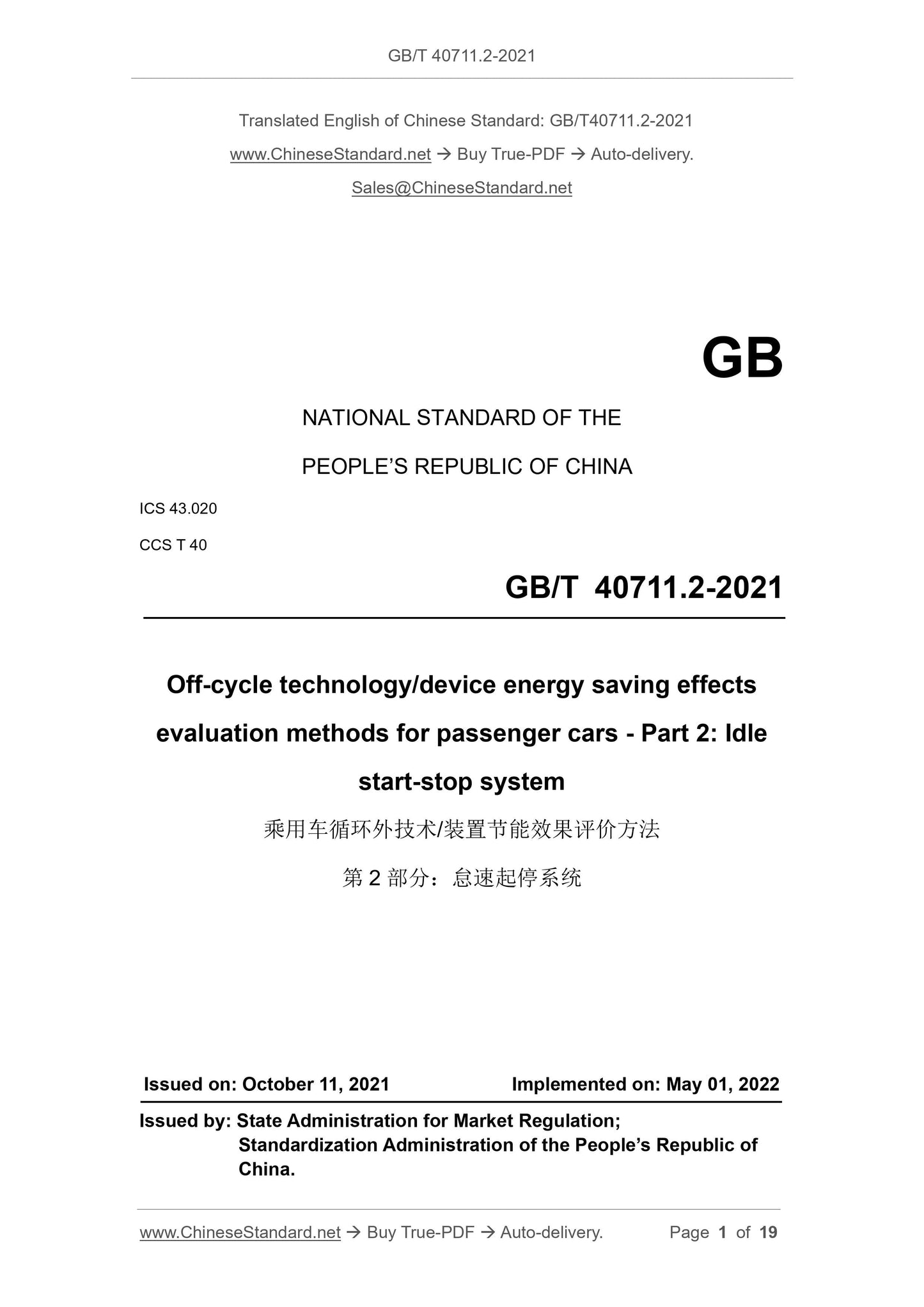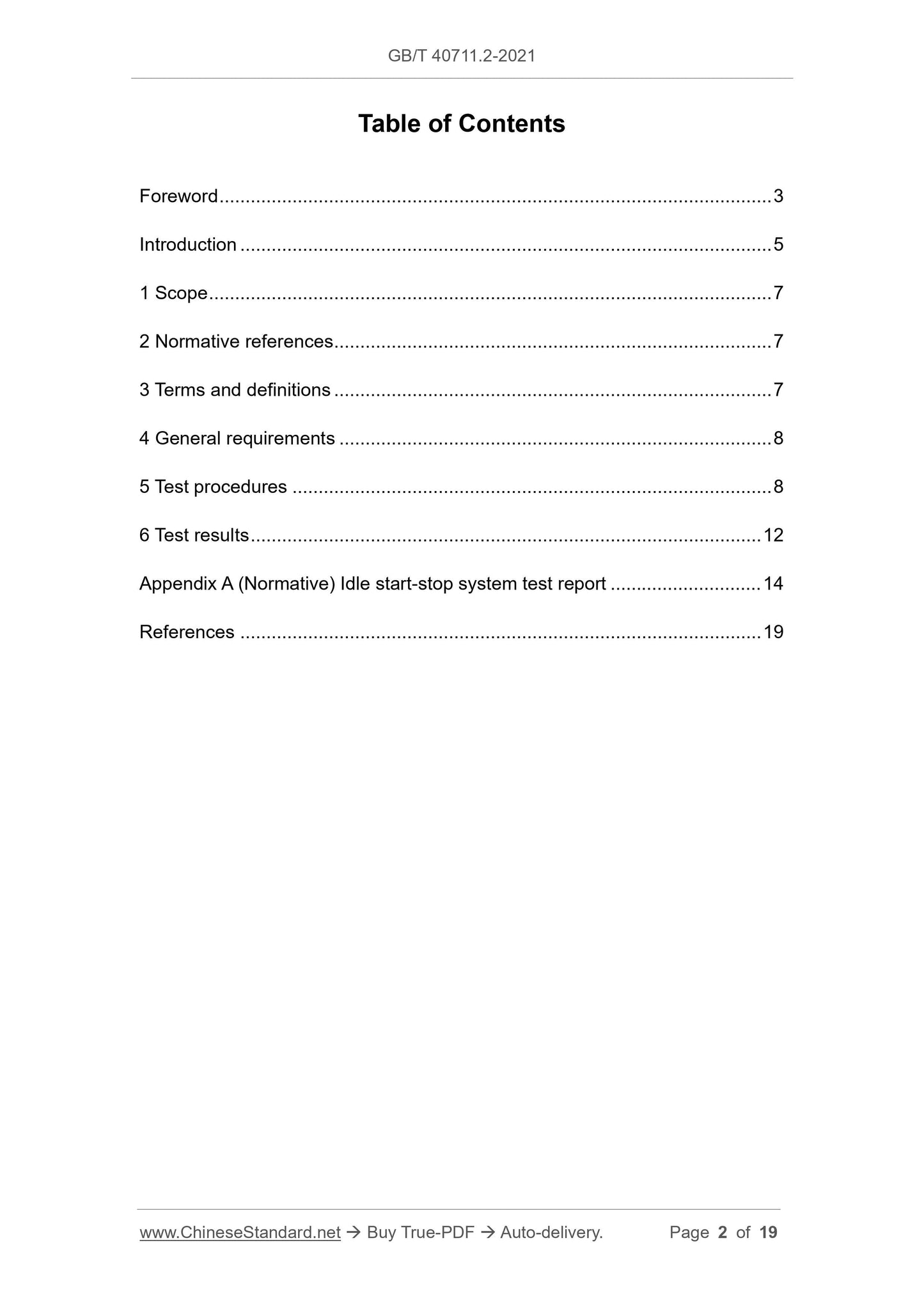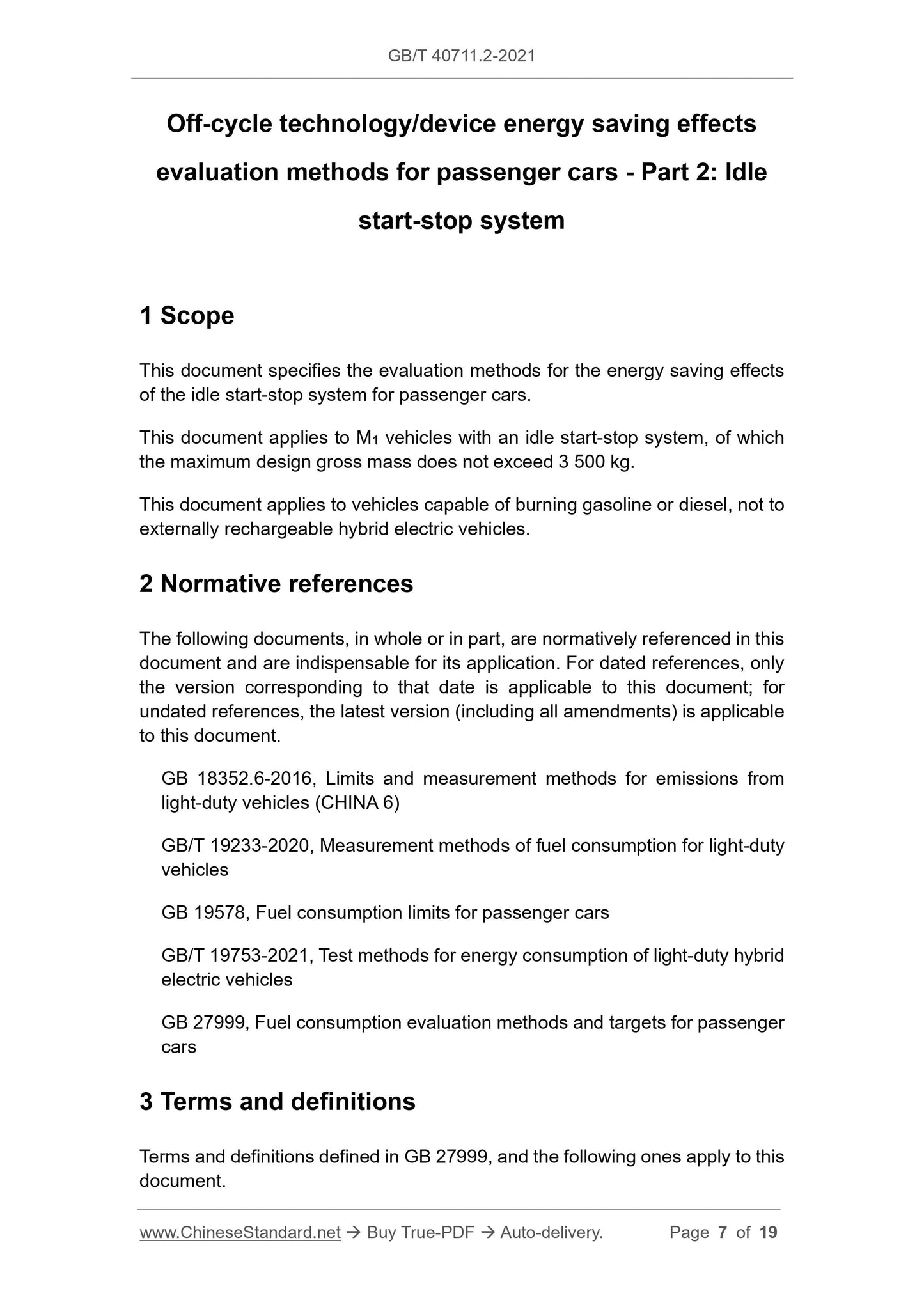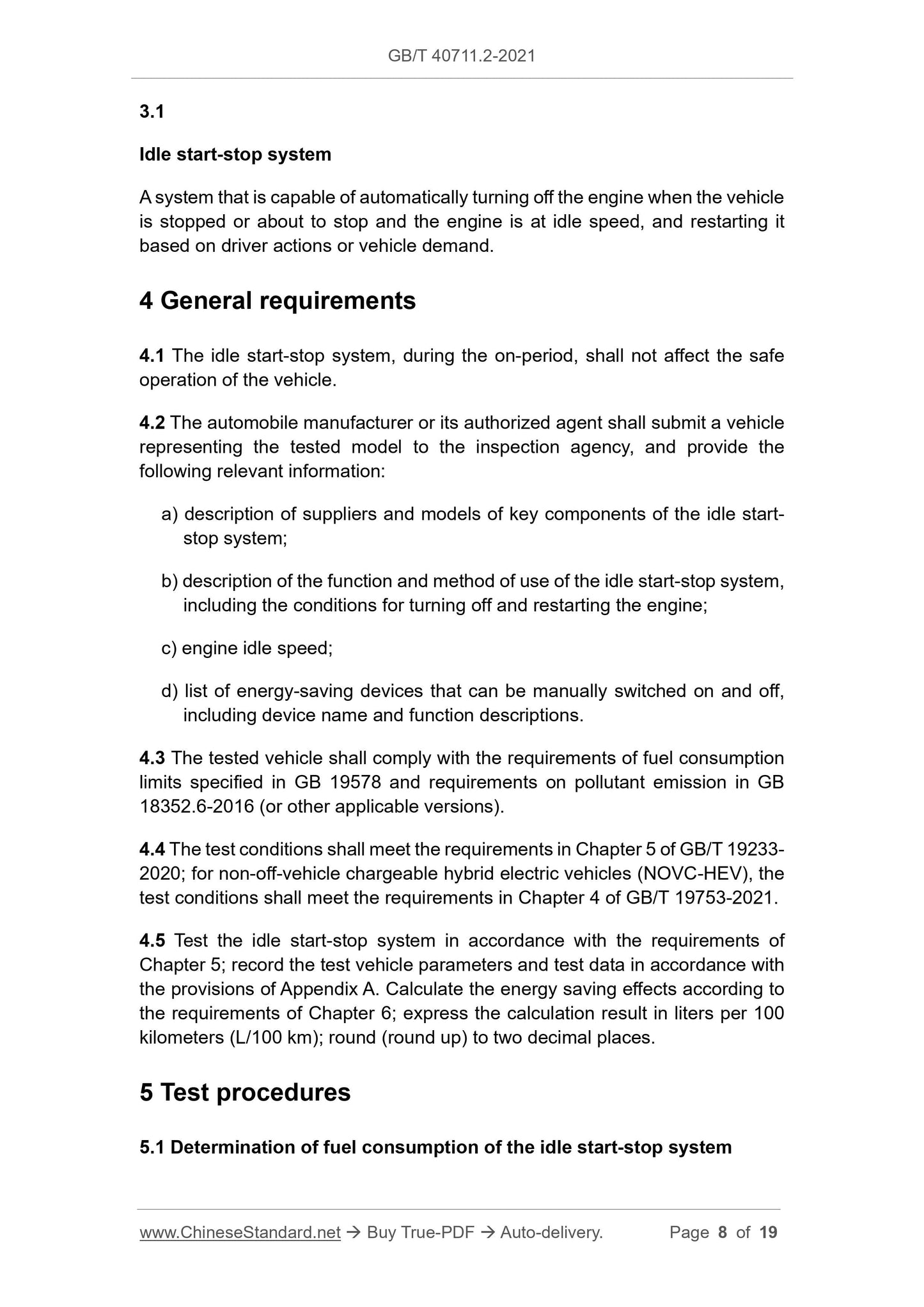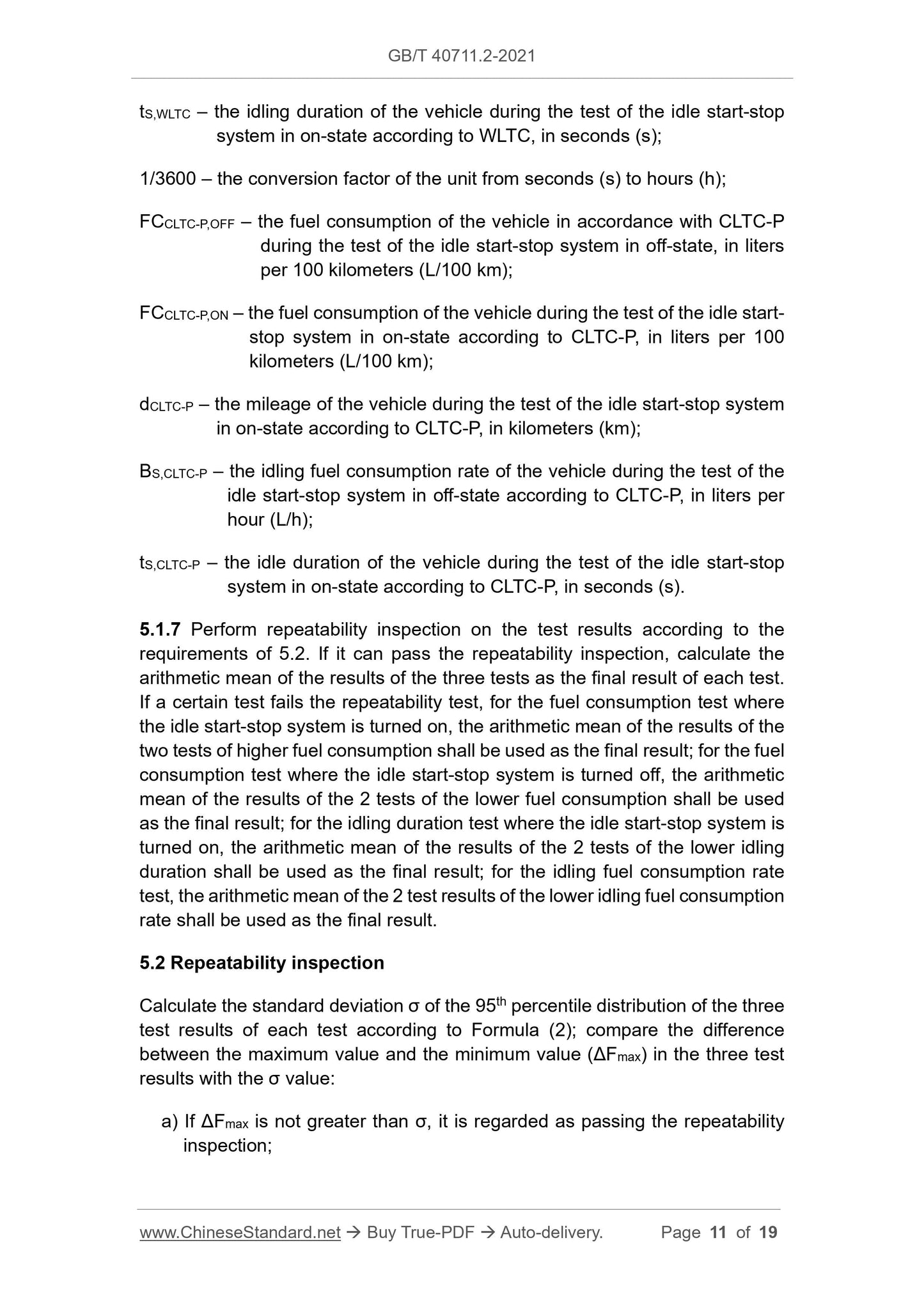1
/
of
5
PayPal, credit cards. Download editable-PDF & invoice in 1 second!
GB/T 40711.2-2021 English PDF (GBT40711.2-2021)
GB/T 40711.2-2021 English PDF (GBT40711.2-2021)
Regular price
$260.00 USD
Regular price
Sale price
$260.00 USD
Unit price
/
per
Shipping calculated at checkout.
Couldn't load pickup availability
Delivery: 3 seconds. Download true-PDF + Invoice.
Get QUOTATION in 1-minute: Click GB/T 40711.2-2021
Historical versions: GB/T 40711.2-2021
Preview True-PDF (Reload/Scroll if blank)
GB/T 40711.2-2021: Off-cycle technology/device energy saving effects evaluation methods for passenger cars -- Part 2: Idle start-stop system
GB/T 40711.2-2021
GB
NATIONAL STANDARD OF THE
PEOPLE’S REPUBLIC OF CHINA
ICS 43.020
CCS T 40
Off-cycle technology/device energy saving effects
evaluation methods for passenger cars - Part 2: Idle
start-stop system
ISSUED ON: OCTOBER 11, 2021
IMPLEMENTED ON: MAY 01, 2022
Issued by: State Administration for Market Regulation;
Standardization Administration of the People’s Republic of
China.
Table of Contents
Foreword ... 3
Introduction ... 5
1 Scope ... 7
2 Normative references ... 7
3 Terms and definitions ... 7
4 General requirements ... 8
5 Test procedures ... 8
6 Test results ... 12
Appendix A (Normative) Idle start-stop system test report ... 14
References ... 19
Off-cycle technology/device energy saving effects
evaluation methods for passenger cars - Part 2: Idle
start-stop system
1 Scope
This document specifies the evaluation methods for the energy saving effects
of the idle start-stop system for passenger cars.
This document applies to M1 vehicles with an idle start-stop system, of which
the maximum design gross mass does not exceed 3 500 kg.
This document applies to vehicles capable of burning gasoline or diesel, not to
externally rechargeable hybrid electric vehicles.
2 Normative references
The following documents, in whole or in part, are normatively referenced in this
document and are indispensable for its application. For dated references, only
the version corresponding to that date is applicable to this document; for
undated references, the latest version (including all amendments) is applicable
to this document.
GB 18352.6-2016, Limits and measurement methods for emissions from
light-duty vehicles (CHINA 6)
GB/T 19233-2020, Measurement methods of fuel consumption for light-duty
vehicles
GB 19578, Fuel consumption limits for passenger cars
GB/T 19753-2021, Test methods for energy consumption of light-duty hybrid
electric vehicles
GB 27999, Fuel consumption evaluation methods and targets for passenger
cars
3 Terms and definitions
Terms and definitions defined in GB 27999, and the following ones apply to this
document.
3.1
Idle start-stop system
A system that is capable of automatically turning off the engine when the vehicle
is stopped or about to stop and the engine is at idle speed, and restarting it
based on driver actions or vehicle demand.
4 General requirements
4.1 The idle start-stop system, during the on-period, shall not affect the safe
operation of the vehicle.
4.2 The automobile manufacturer or its authorized agent shall submit a vehicle
representing the tested model to the inspection agency, and provide the
following relevant information:
a) description of suppliers and models of key components of the idle start-
stop system;
b) description of the function and method of use of the idle start-stop system,
including the conditions for turning off and restarting the engine;
c) engine idle speed;
d) list of energy-saving devices that can be manually switched on and off,
including device name and function descriptions.
4.3 The tested vehicle shall comply with the requirements of fuel consumption
limits specified in GB 19578 and requirements on pollutant emission in GB
18352.6-2016 (or other applicable versions).
4.4 The test conditions shall meet the requirements in Chapter 5 of GB/T 19233-
2020; for non-off-vehicle chargeable hybrid electric vehicles (NOVC-HEV), the
test conditions shall meet the requirements in Chapter 4 of GB/T 19753-2021.
4.5 Test the idle start-stop system in accordance with the requirements of
Chapter 5; record the test vehicle parameters and test data in accordance with
the provisions of Appendix A. Calculate the energy saving effects according to
the requirements of Chapter 6; express the calculation result in liters per 100
kilometers (L/100 km); round (round up) to two decimal places.
5 Test procedures
5.1 Determination of fuel consumption of the idle start-stop system
tS,WLTC – the idling duration of the vehicle during the test of the idle start-stop
system in on-state according to WLTC, in seconds (s);
1/3600 – the conversion factor of the unit from seconds (s) to hours (h);
FCCLTC-P,OFF – the fuel consumption of the vehicle in accordance with CLTC-P
during the test of the idle start-stop system in off-state, in liters
per 100 kilometers (L/100 km);
FCCLTC-P,ON – the fuel consumption of the vehicle during the test of the idle start-
stop system in on-state according to CLTC-P, in liters per 100
kilometers (L/100 km);
dCLTC-P – the mileage of the vehicle during the test of the idle start-stop system
in on-state according to CLTC-P, in kilometers (km);
BS,CLTC-P – the idling fuel consumption rate of the vehicle during the test of the
idle start-stop system in off-state according to CLTC-P, in liters per
hour (L/h);
tS,CLTC-P – the idle duration of the vehicle during the test of the idle start-stop
system in on-state according to CLTC-P, in seconds (s).
5.1.7 Perform repeatability inspection on the test results according to the
requirements of 5.2. If it can pass the repeatability inspection, calculate the
arithmetic mean of the results of the three tests as the final result of each test.
If a certain test fails the repeatability test, for the fuel consumption test where
the idle start-stop system is turned on, the arithmetic mean of the results of the
two tests of higher fuel consumption shall be used as the final result; for the fuel
consumption test where the idle start-stop system is turned off, the arithmetic
mean of the results of the 2 tests of the lower fuel consumption shall be used
as the final result; for the idling duration test where the idle start-stop system is
turned on, the arithmetic mean of the results of the 2 tests of the lower idling
duration shall be used as the final result; for the idling fuel consumption rate
test, the arithmetic mean of the 2 test results of the lower idling fuel consumption
rate shall be used as the final result.
5.2 Repeatability inspection
Calculate the standard deviation σ of the 95th percentile distribution of the three
test results of each test according to Formula (2); compare the difference
between the maximum value and the minimum value (ΔFmax) in the three test
results with the σ value:
a) If ΔFmax is not greater than σ, it is regarded as passing the repeatability
inspection;
Get QUOTATION in 1-minute: Click GB/T 40711.2-2021
Historical versions: GB/T 40711.2-2021
Preview True-PDF (Reload/Scroll if blank)
GB/T 40711.2-2021: Off-cycle technology/device energy saving effects evaluation methods for passenger cars -- Part 2: Idle start-stop system
GB/T 40711.2-2021
GB
NATIONAL STANDARD OF THE
PEOPLE’S REPUBLIC OF CHINA
ICS 43.020
CCS T 40
Off-cycle technology/device energy saving effects
evaluation methods for passenger cars - Part 2: Idle
start-stop system
ISSUED ON: OCTOBER 11, 2021
IMPLEMENTED ON: MAY 01, 2022
Issued by: State Administration for Market Regulation;
Standardization Administration of the People’s Republic of
China.
Table of Contents
Foreword ... 3
Introduction ... 5
1 Scope ... 7
2 Normative references ... 7
3 Terms and definitions ... 7
4 General requirements ... 8
5 Test procedures ... 8
6 Test results ... 12
Appendix A (Normative) Idle start-stop system test report ... 14
References ... 19
Off-cycle technology/device energy saving effects
evaluation methods for passenger cars - Part 2: Idle
start-stop system
1 Scope
This document specifies the evaluation methods for the energy saving effects
of the idle start-stop system for passenger cars.
This document applies to M1 vehicles with an idle start-stop system, of which
the maximum design gross mass does not exceed 3 500 kg.
This document applies to vehicles capable of burning gasoline or diesel, not to
externally rechargeable hybrid electric vehicles.
2 Normative references
The following documents, in whole or in part, are normatively referenced in this
document and are indispensable for its application. For dated references, only
the version corresponding to that date is applicable to this document; for
undated references, the latest version (including all amendments) is applicable
to this document.
GB 18352.6-2016, Limits and measurement methods for emissions from
light-duty vehicles (CHINA 6)
GB/T 19233-2020, Measurement methods of fuel consumption for light-duty
vehicles
GB 19578, Fuel consumption limits for passenger cars
GB/T 19753-2021, Test methods for energy consumption of light-duty hybrid
electric vehicles
GB 27999, Fuel consumption evaluation methods and targets for passenger
cars
3 Terms and definitions
Terms and definitions defined in GB 27999, and the following ones apply to this
document.
3.1
Idle start-stop system
A system that is capable of automatically turning off the engine when the vehicle
is stopped or about to stop and the engine is at idle speed, and restarting it
based on driver actions or vehicle demand.
4 General requirements
4.1 The idle start-stop system, during the on-period, shall not affect the safe
operation of the vehicle.
4.2 The automobile manufacturer or its authorized agent shall submit a vehicle
representing the tested model to the inspection agency, and provide the
following relevant information:
a) description of suppliers and models of key components of the idle start-
stop system;
b) description of the function and method of use of the idle start-stop system,
including the conditions for turning off and restarting the engine;
c) engine idle speed;
d) list of energy-saving devices that can be manually switched on and off,
including device name and function descriptions.
4.3 The tested vehicle shall comply with the requirements of fuel consumption
limits specified in GB 19578 and requirements on pollutant emission in GB
18352.6-2016 (or other applicable versions).
4.4 The test conditions shall meet the requirements in Chapter 5 of GB/T 19233-
2020; for non-off-vehicle chargeable hybrid electric vehicles (NOVC-HEV), the
test conditions shall meet the requirements in Chapter 4 of GB/T 19753-2021.
4.5 Test the idle start-stop system in accordance with the requirements of
Chapter 5; record the test vehicle parameters and test data in accordance with
the provisions of Appendix A. Calculate the energy saving effects according to
the requirements of Chapter 6; express the calculation result in liters per 100
kilometers (L/100 km); round (round up) to two decimal places.
5 Test procedures
5.1 Determination of fuel consumption of the idle start-stop system
tS,WLTC – the idling duration of the vehicle during the test of the idle start-stop
system in on-state according to WLTC, in seconds (s);
1/3600 – the conversion factor of the unit from seconds (s) to hours (h);
FCCLTC-P,OFF – the fuel consumption of the vehicle in accordance with CLTC-P
during the test of the idle start-stop system in off-state, in liters
per 100 kilometers (L/100 km);
FCCLTC-P,ON – the fuel consumption of the vehicle during the test of the idle start-
stop system in on-state according to CLTC-P, in liters per 100
kilometers (L/100 km);
dCLTC-P – the mileage of the vehicle during the test of the idle start-stop system
in on-state according to CLTC-P, in kilometers (km);
BS,CLTC-P – the idling fuel consumption rate of the vehicle during the test of the
idle start-stop system in off-state according to CLTC-P, in liters per
hour (L/h);
tS,CLTC-P – the idle duration of the vehicle during the test of the idle start-stop
system in on-state according to CLTC-P, in seconds (s).
5.1.7 Perform repeatability inspection on the test results according to the
requirements of 5.2. If it can pass the repeatability inspection, calculate the
arithmetic mean of the results of the three tests as the final result of each test.
If a certain test fails the repeatability test, for the fuel consumption test where
the idle start-stop system is turned on, the arithmetic mean of the results of the
two tests of higher fuel consumption shall be used as the final result; for the fuel
consumption test where the idle start-stop system is turned off, the arithmetic
mean of the results of the 2 tests of the lower fuel consumption shall be used
as the final result; for the idling duration test where the idle start-stop system is
turned on, the arithmetic mean of the results of the 2 tests of the lower idling
duration shall be used as the final result; for the idling fuel consumption rate
test, the arithmetic mean of the 2 test results of the lower idling fuel consumption
rate shall be used as the final result.
5.2 Repeatability inspection
Calculate the standard deviation σ of the 95th percentile distribution of the three
test results of each test according to Formula (2); compare the difference
between the maximum value and the minimum value (ΔFmax) in the three test
results with the σ value:
a) If ΔFmax is not greater than σ, it is regarded as passing the repeatability
inspection;
Share
